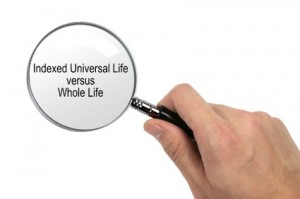Here are four reasons why Equity Indexed Universal Life (EIUL) policies aren’t recommended when you want predictable, guaranteed growth and/or if you intend to use the policy for becoming your own financing source, as is the case with Bank On Yourself. This information comes from a top executive at a major life insurance company that sells both EIUL and Dividend-Paying Whole Life policies:
Like all Universal Life (UL) policies, EIUL is essentially term insurance plus a side fund. Net premiums (premiums less any premium load) are deposited into the side fund and cost of insurance and expense loads are taken from the side fund. If the side fund is large enough to support all of the money that has to come out of it (including loans, loan interest, and withdrawals), the policy is workable in a self-financing context. If it does not, the policy may lapse and the lapse may cause a taxable event.
How likely is a lapse to happen? If funded at the max throughout the policy’s lifetime, not very likely, but there are a few things that need to be considered:
 Your Cash Values Could Be Lowered: If the EIUL policy has been designed using a “guideline premium test” for life insurance, the maximum amount of premium that can be put in the policy will generally be lower than the maximum amount of premium that can be put in a whole life policy that has been designed using the “cash value accumulation test” for life insurance. Less money in the policy will result in a lower cash value build up, of course, unless the cash value buildup consistently receives a higher interest rate.
Your Cash Values Could Be Lowered: If the EIUL policy has been designed using a “guideline premium test” for life insurance, the maximum amount of premium that can be put in the policy will generally be lower than the maximum amount of premium that can be put in a whole life policy that has been designed using the “cash value accumulation test” for life insurance. Less money in the policy will result in a lower cash value build up, of course, unless the cash value buildup consistently receives a higher interest rate.
The EIUL policy could be designed to take more cash by either buying an increasing death benefit or buying more insurance, but in both cases, you have increased the amount of insurance coverage that has to be funded and that may result in lower cash values.
 Illustration Fairytales: The potential for lower cash value development should potentially be overcome by the higher interest rates credited to the EIUL policy, but here you have to be careful not to confuse the illustration with reality.
Illustration Fairytales: The potential for lower cash value development should potentially be overcome by the higher interest rates credited to the EIUL policy, but here you have to be careful not to confuse the illustration with reality.
Our EIUL policy can currently be illustrated at 8%. It was designed to have a higher illustrated rate and this rate is supported by both the economy and the loads that have been built into the product. (All things being equal, a product with a higher illustrated rate will generally have higher loads than the one with a lower illustrated rate. After all we are buying the instruments that support these rates from the same sources as everyone else. The money has to come from somewhere.)
But the fact that a product is illustrated at 8% does not mean it will get 8% in any year!
First of all, the “cap rates” will change as economic conditions change. Second, the market does not always go up. Out of the last ten years, the market (i.e. the S&P index in this case) has been up in only 4 years which means that in six of the last ten years the product hasn’t earned anything, although mortality and loans are still coming out. The results financial representatives show their prospects (that make EIUL look so enticing), are based on the product returning 8% in all years.
It is not going to happen!
[See 7 Reasons to Be Wary of Indexed Universal Life Insurance]
 How Loans Can Cause Your Policy To Blow Up: One of the features of most contemporary EIULs is the “non-direct recognition loan”. The company charges a loan interest rate, but the fact that there is a loan does not affect the crediting rate on the policy. Thus if you have an illustration with a 6% loan rate and an 8% illustrated rate, you are illustrating a 2% gain on the loaned amount. You would be ahead to take every dime out of the policy and reinvest it, wouldn’t you? But this mechanism has the same problem as above; if there is no gain in the S&P, there is no credit to the policy.
How Loans Can Cause Your Policy To Blow Up: One of the features of most contemporary EIULs is the “non-direct recognition loan”. The company charges a loan interest rate, but the fact that there is a loan does not affect the crediting rate on the policy. Thus if you have an illustration with a 6% loan rate and an 8% illustrated rate, you are illustrating a 2% gain on the loaned amount. You would be ahead to take every dime out of the policy and reinvest it, wouldn’t you? But this mechanism has the same problem as above; if there is no gain in the S&P, there is no credit to the policy.
FREE Special Report!
Free Special Report reveals the details of what Bank On Yourself is and how it can help you reach your short-term and long-term goals and dreams in the shortest time possible. Grab your free copy now.
If you had borrowed 50% of your cash value and in six out of ten years there was no gain in the policy, you could reduce the policy value by 40% if the loan is not otherwise repaid. This may be doubly devastating, since policy loads are continuing to be taken out.
 Variable Premiums Require Constant Management: Finally, there is the issue of policy management. EIULs are flexible premium policies, which allows policyholders to pay premiums or not, or to pay premiums at a level of their choosing. The problem is that they do not always choose to pay premiums at the level they should in order to properly support the policy, nor are they in a good position to analyze the impact of a series of down years in the market and make any adjustments in their premium accordingly.
Variable Premiums Require Constant Management: Finally, there is the issue of policy management. EIULs are flexible premium policies, which allows policyholders to pay premiums or not, or to pay premiums at a level of their choosing. The problem is that they do not always choose to pay premiums at the level they should in order to properly support the policy, nor are they in a good position to analyze the impact of a series of down years in the market and make any adjustments in their premium accordingly.

As I see it, the purpose of the Bank On Yourself concept is to develop a secure financial floor that grows in a steady, predictable manner. This gives you the wellspring of funds from which other investments can be made. The fixed premium of the whole life insurance contract imposes a certain discipline on the policyholder; requiring the payment of premium in order to keep the program in force. (It also means that if the policyholder elects to have the premium paid by the policy, the amount required to pay the premium is a fixed rather than an increasing amount.)
Keep in mind that no two Bank On Yourself plans are alike…
Each is custom tailored to your unique situation, goals and dreams. To find out what your bottom-line, guaranteed numbers and results would be if you added Bank On Yourself to your financial plan, request a free, no-obligation Analysis now, if you haven’t already done so.
If you’re wondering where you’ll find the money to fund your plan, keep in mind the Bank On Yourself Professionals are masters at helping people restructure their finances to free up seed money to fund a plan. Here are the eight most common places they look.
REQUEST YOUR
FREE ANALYSIS!
The EIUL is much more like an investment.
It has the potential for higher returns, but it also has the potential, if the returns are not there, that the whole program will implode as the cash values are depleted by cost of insurance, policy loads, unexpectedly low interest rates, skipped or sporadic payments, or unexpectedly high loan interest rates (in comparison to the rate credited to the policy). With that in mind, whole life insurance looks like a much safer investment.
Take the $100,000 Challenge!
Bank On Yourself challenges you to find any other product or strategy that can match or beat the many advantages and guarantees of a properly designed dividend-paying whole life policy!
We have a $100,000 cash reward for you if your best saving or investing method can beat Bank On Yourself. Don’t take our word – Take the $100,000 Challenge now!


